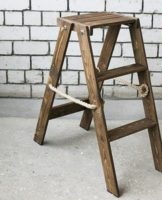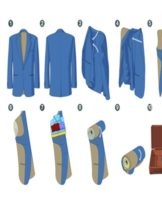How to quickly iron tulle after washing and the rules for choosing the temperature
Tulle is an airy and eye-catching material used for sewing clothes and various interior details. The main disadvantage of this fabric is the difficulty of maintenance, especially when it comes to ironing. Many owners of tulle items do not know what to do with them after washing and what nuances should be considered. Let's see how to iron tulle correctly at home without damaging an expensive item.
Product Features
Tulle is a light and pleasant to the touch material and comes in the form of a smooth or patterned fabric. There are many ways to make tulle, which affect the final set of fabric characteristics:
- Organza.
Polyester is used as the base material in the production of organza, which gives tulle increased density and resistance to damage. Organza wrinkles less during operation and does not accumulate dust on its surface, which is typical of other types of tulle.
- Sail.
The veil differs from other options with a matte fabric texture. Otherwise, it is just as dense and durable. In the production of the veil, cotton, silk and woolen fibers are used.
- Report.
The mesh is a tulle with a honeycomb structure, thanks to which the tulle transmits light well and looks extravagant. Due to its structure, the curtain accumulates a lot of dust, which is a significant inconvenience for people prone to allergic reactions.
- Muslin.
Plain tulle, which results in exceptional durability of the fabric. It is made from natural and synthetic materials.
- Chiffon.
Combines well with other materials, allowing you to create unexpected combinations of colors and shapes. It is made of cotton or silk, which affects the overall durability of the fabric.
- Kiseya.
The fabric is made by loosely joining individual threads into an overall composition, which gives the fabric increased breathability and lightness.
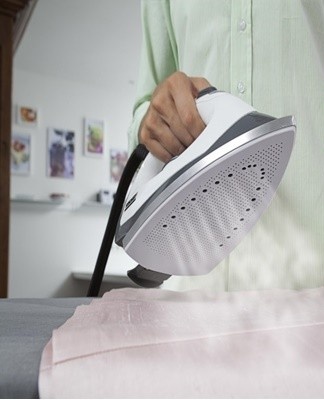
Basic methods of ironing after washing
Novice housewives assume that ironing tulle is possible only with an iron. This is a misconception as there are many ways to smooth a freshly washed tulle curtain, including:
- use of a steam generator;
- smooth the fabric with a steamer;
- hanging over the cornice;
- regular ironing.
To note! Some ironing methods are considered universal, while others are used only for certain types of fabrics. Consider this nuance when choosing the right option.
Weighing on the ledge
Not everyone successfully irons a large piece of fabric without leaving creases and creases on its surface. In such a situation, a simple and universal method of weighing on the cornice will help. To implement it, all you need to do is:
- washing equipment;
- without waiting for it to dry completely, the tulle is suspended from the cornice;
- under its own weight, the fabric straightens, acquiring a neat look.
The method does not require the use of specific equipment or special skills.
Steam generator
The steam generator allows you to remove all irregularities on the tulle in the shortest possible time.
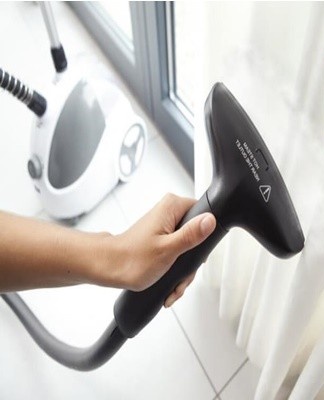
Algorithm of actions:
- we prepare the steam generator for work;
- we hang the curtains on the cornice;
- we treat the surface of the fabric with steam, making smooth movements from top to bottom.
Thanks to the high steam temperature, the tulle is smoothed and all the wrinkles that spoil its appearance disappear.
Iron
Using an iron is considered a common thing for everyone. However, in the case of tulle, ironing takes on many nuances depending on the type of fabric.
Among the general recommendations suitable for any treated material, there are:
- Do not exceed the maximum permitted ironing temperature indicated on the product label.
- Any designs on the fabric or seams are ironed through multiple layers of gauze, starting from the front.
- Try ironing a slightly damp curtain after wringing out excess liquid.
Spray
Using the spray method is similar to the weigh-on-a-ledge method. All stitches are repeated in the same way, and the only difference is to maintain the moisture content of the fabric until all visible defects have been removed. For spot humidification, a spray bottle is best suited. Alternatively, you can gently moisten the tulle by hand.

What to do if the fabric is large
The main ironing difficulties arise with large pieces of fabric, such as curtains or curtains.Long fabrics are difficult to straighten and must be designed with various assistive techniques. There are a lot of them, but one idea unites them - the curtain is hung on the cornice, after which any method suitable for the housewife is used. Most often used:
- smooth the curtain under its own weight;
- use of a steam generator;
- using a pot of boiling water. This is an economical analogue of a steam generator that works in a similar technique.
Features of ironing certain materials
Most types of fabrics combined under one concept of tulle have similar processing methods. However, there are several types of materials that require special skills to work with. These include:
- organza;
- nylon.
Let's take a closer look.
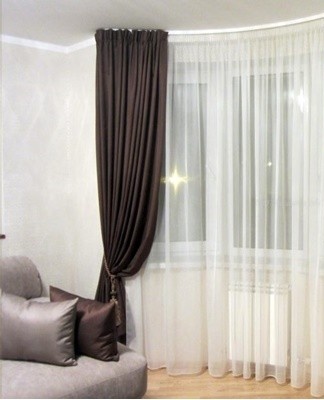
Organza
Delicate fabric, with which interaction requires special care. If you do not pay enough attention to it during processing, the product is easily damaged and becomes unsuitable for further use. When eliminating wrinkles on organza curtains, consider the following nuances:
- Some household appliances used for ironing fabrics have a steam boost function. Its use is not recommended, since wavy folds appear on the surface of organza, which are difficult to get rid of in the future.
- Organza is only ironed when completely dry.
- At high temperatures, the soleplate of the iron may begin to stick to the surface of the iron. To avoid this situation, the curtain is soaked in a saline solution after washing. For its manufacture, 5 liters of water and 20 grams of salt are taken.
Nylon
Nylon is no less capricious material whose heat treatment requires some preparation:
- During ironing, there should be a gauze pad between the curtain and the soleplate of the iron.
- Do not heat the iron above 100 oh... When the specified temperature is exceeded, wavy folds form on the surface of the nylon.
- Do not over dry the nylon before ironing. The drier the tulle, the more difficult it is to influence it.
- It is forbidden to moisten the fabric with a spray bottle, since there is a high probability of the formation of yellow streaks on its surface.
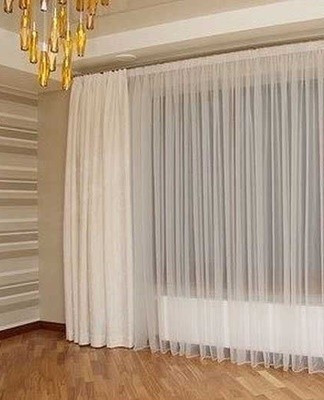
What types of ironing do not need
Some types of materials from which tulle is made do not require ironing after washing or require minimal heat treatment. These types include:
- synthetic fabrics;
- cotton products;
- linen products.
Synthetic fabric
The peculiarity of synthetic is that its structure does not undergo significant changes after washing. Accordingly, there is no need for additional processing of tulle, which greatly simplifies its operation. It is enough to wash the item, after which it can be hung on the cornice.
If the need for ironing nevertheless arises, the curtain is folded in several layers, after which it is treated with a hot iron, the temperature of the soleplate of which should not exceed 120 .
Cotton
Cotton curtains also do not require additional heat treatment, and the weight of the product is enough to eliminate random wrinkles. Housewives are very fond of cotton products for their ease of use and pleasant appearance.
Linen
The technology for working with linen curtains is similar to synthetic curtains. Enough:
- washing the product;
- hang it on the cornice.
If ironing is essential, preheat the iron to one hundred degrees and use gauze as a buffer.
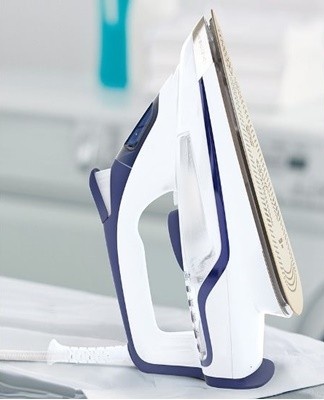
Tips & Tricks
If the fabric creases quickly during use or after washing, you're probably doing something wrong. To avoid such situations, observe the following general rules:
- Regardless of the type of fabric, read the manufacturer's instructions on the label before washing and ironing.
- When using an iron, in most cases the curtain is processed through wet gauze folded in several layers.
- Before ironing, start working on an inconspicuous area of the fabric, then move on to the rest of the curtain. If something goes wrong and marks remain on the fabric, it won't be very noticeable.
- Make sure there is no dirt on the soleplate of the iron, otherwise it will imprint on the tulle in an ugly stain.
- The maximum allowable iron temperature is 150 oh... Exceeding it is unacceptable for any type of fabric, be it mesh or organza.

